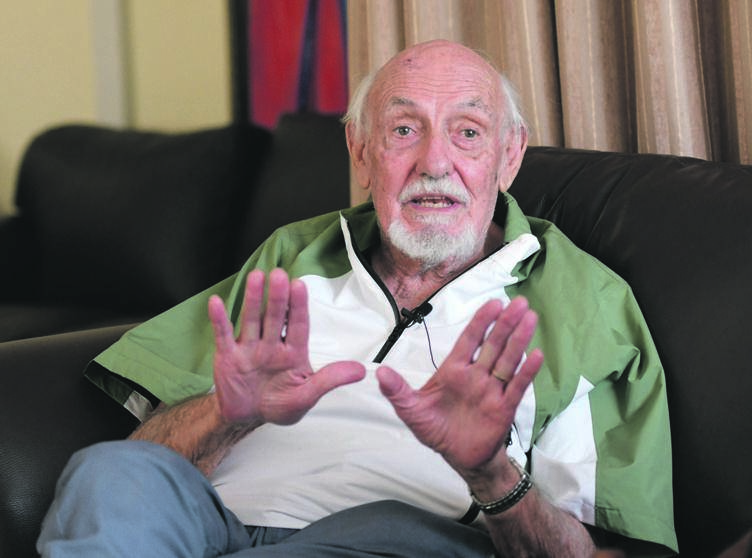Small act of protest – covered by a carpet in the library and forgotten – might look innocuous, but it is a reminder of UWC struggle students
Just south of Pretoria, on a small hill in a nature reserve, sits the imposing monument that was built to honour the voortrekkers of South Africa and their epic journey that was so pivotal in shaping the history of this nation.
The Voortrekker Monument, with its communion wagon, its 1938 rock pile and its commanding presence, was designed by architect Gerard Moerdijk in the late 1930s and finished in 1949.
There was great symbolism built into the very heart of the monument.
Every year, on December 16, a shaft of sunlight penetrates the dome at exactly the right angle and falls gently on the cenotaph below, lighting up five simple words written in Afrikaans: “Ons vir jou Suid Afrika.”
Five words that sum up the nationalism of the people who built that monument during the years when they were an unstoppable political force sweeping into power.
Most South Africans know that story. But very few know that a similar scene unfolds a world away every year in the Cape Town suburb of Bellville – a direct counterpoint to the scene at the Voortrekker Monument.
At midday every June 16, on the campus of the University of the Western Cape (UWC), a ray of sunlight pierces the glass dome in the library and hits a glass brick strategically placed in its floor, shining through and down into an auditorium below where students sit studying quietly or listening to a public lecture.
These opposing scenes are two sides of the same coin, designed on the same astronomical principle, but for very different reasons.
The symbolism of a shaft of light on June 16 illuminating the struggle for education was the secret brainchild of Professor Jaap Durand, who was the vice-rector at UWC when the library was built.
“It was my parody of what was happening at the Voortrekker Monument,” he said on a rare return visit to the campus where he spent so much of his career and one that he was instrumental in reshaping from a “bush college” into a world-class educational facility.
Durand is an author, a theologian and an academic whose role in the struggle for freedom cannot be overstated.
Now well into his eighties, he was born on June 5 1934 in the Free State.
He studied philosophy and theology at the University of the Free State before furthering his studies at Stellenbosch University and then at the Free University in Amsterdam.
He began his career working as a minister in the Transkei before moving into academia and taking up a position as a professor of systematic theology at UWC, where he proved himself so valuable that he was appointed deputy vice-chancellor in 1981.
“He began the process of reconceptualising UWC’s intellectual vision, drawing the deans and other leaders together around the process and unleashing exciting intellectual vitality in a university in the thick of political upheaval,” said a colleague at the time – the late professor Stanley Ridge.
During those years the UWC campus was one of the few cradles of resistance to apartheid and the vice-rector was at the forefront of that struggle.
Protests during the 1970s had resulted in the appointment of the first black rector of a university in South African history, Professor Richard van der Ross, which led to a blossoming of intellectual freedom and a firm commitment to nonracialism.
In 1982 the university formally rejected the apartheid ideology in its mission statement, setting up a very confrontational relationship with the government of the day.
It was in that difficult environment that the UWC leadership was given the task of building new facilities on the campus, including a library.
Another colleague who was on the planning committee at the time, Professor Harold Herman, remembers that “the apartheid government had created only the four science buildings, the education building and the arts building where there was only one lecture hall. That’s where all the students of that time, about 600, would gather.”
Together, they came up with a new plan to develop the campus which they called “UWC 2001”.
Durand spent a lot of time with the architect during those early days when they were planning the extensions, including the students’ union and the massive courtyard in the centre of the campus.
While they were working on the library, the June 16 commemoration rolled around and the professor thought to himself: “The voortrekkers have their big monument in Pretoria. We want something similar, but not to remember the voortrekkers ... to remember the struggle of the students of UWC against the government. I want the same thing to happen here.”
In those days there was so much spying on the staff and academics by the secret police that meetings were often held outdoors and decisions were often taken during long walks around the campus.
At first the architect was unsure of Durand’s plan, but after a few days he came up with a solution that he thought would work and they quietly began working on getting that beam of sunlight through the beautiful big building and into the hall below.
Their plan worked to perfection and today you can still stand in that auditorium below the library and look up to see the light from the small, innocuous pane of glass in the roof.
However, very few people knew about its symbolism.
Even Herman, who was on the construction planning committee, had no idea until almost 30 years later.
The small act of protest was covered by a carpet in the library and forgotten as the university adapted to life in post-apartheid South Africa and set its sights on developing a new generation of leaders.
But, on a chance visit back to the university, Durand happened to recount the story and look for the glass brick, much to the amazement of the staff.
UWC took a decision to commemorate that symbolic act of defiance and of the defence of education.
The professor accomplished so much in his life that he tends to dismiss this small gesture as a parody, or just “my little joke”.
But to many people, it holds huge significance. Patricia Lawrence, the director of institutional advancement at UWC, believes it’s more than that.
“It might look innocuous but it is a very powerful symbol of what we stand for, and a parody of so much more.”
TALK TO US
In what other symbolic ways should we honour the heroes of June 16?
SMS us on 35697 using the keyword JUNE and tell us what you think. Please include your name and province. SMSes cost R1.50. By participating, you agree to receive occasional marketing material




 Publications
Publications
 Partners
Partners










